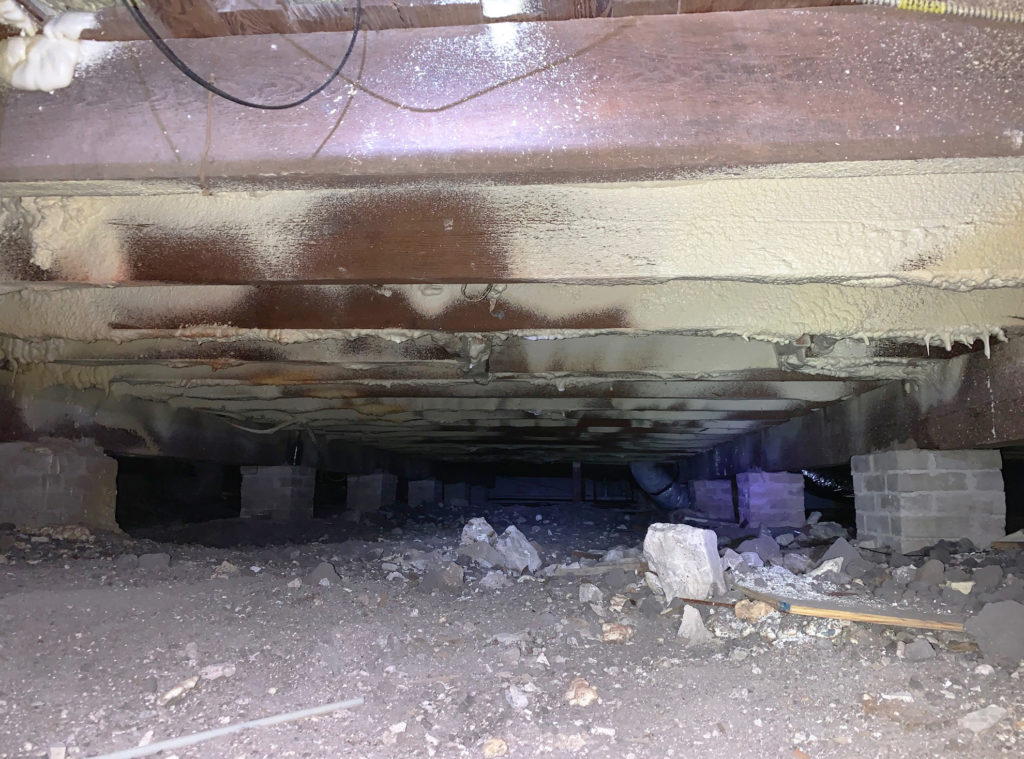Resilience Treatments & Strategies
Basements and Crawl Spaces

Description
Part of your building’s substructure. The lowest stories of a building, partially or entirely below ground. Finished basements can be occupiable spaces that are climate controlled and furnished. Basements solely for storage and utilities might lack these features, leaving them potentially vulnerable to disasters. Crawl spaces are also considered here, which are not full-height like basements and may or may not be fully enclosed.
Typical risk factor of this component:
Moderate
A basement has moderate exposure to floodwaters, but little exposure to elements such as wind and rain. Its importance to the structure’s stability and the impact a failure might have on other assemblies are both low.
Typical Damages from Floods or Hurricanes
- Basement walls and/or floors are buckling from exterior forces (e.g., hydrostatic pressure from surrounding soil saturated by water)
- Materials stored in basement become waterlogged and/or moldy
Other common conditions contributing to vulnerability towards floods or hurricanes
- Lack of protective coatings or finishes in basement or crawl space, or damage to existing
Resilience Treatments and Strategies
In-house
- Carefully pump out water and ventilate walls to allow waterlogged surfaces to dry out.
Professional needed [type]
Install temporary supporting works (e.g., shoring, bracing, planking, strutting, jacking) [engineer].
Reinforce basement walls with structural stiffeners (e.g. deep anchoring, buttresses, reinforcement bars) to improve strength against hydraulic forces [engineer].
Apply new or repair existing protective waterproof coating (see also NPS Preservation Brief #39) [architect].
Basements and Crawl Spaces

Description
Part of your building’s substructure. The lowest stories of a building, partially or entirely below ground. Finished basements can be occupiable spaces that are climate controlled and furnished. Basements solely for storage and utilities might lack these features, leaving them potentially vulnerable to disasters. Crawl spaces are also considered here, which are not full-height like basements and may or may not be fully enclosed.
Typical risk factor of this component:
Moderate
A basement has moderate exposure to floodwaters, but little exposure to elements such as wind and rain. Its importance to the structure’s stability and the impact a failure might have on other assemblies are both low.
Typical Damages from Floods or Hurricanes
- Basement walls and/or floors are buckling from exterior forces (e.g., hydrostatic pressure from surrounding soil saturated by water)
- Materials stored in basement become waterlogged and/or moldy
Other common conditions contributing to vulnerability towards floods or hurricanes
- Lack of protective coatings or finishes in basement or crawl space, or damage to existing
Resilience Treatments and Strategies
In-house
- Carefully pump out water and ventilate walls to allow waterlogged surfaces to dry out.
Professional needed [type]
Install temporary supporting works (e.g., shoring, bracing, planking, strutting, jacking) [engineer].
Reinforce basement walls with structural stiffeners (e.g. deep anchoring, buttresses, reinforcement bars) to improve strength against hydraulic forces [engineer].
Apply new or repair existing protective waterproof coating (see also NPS PreservationBrief #39) [architect].